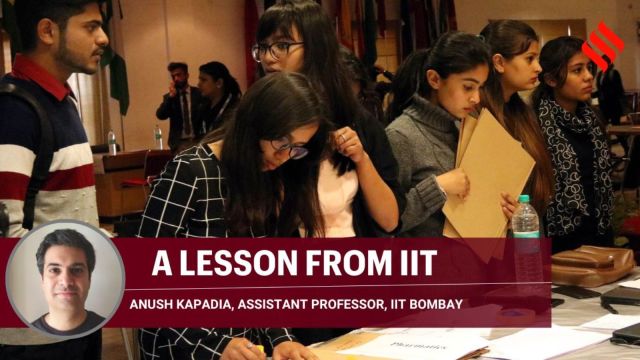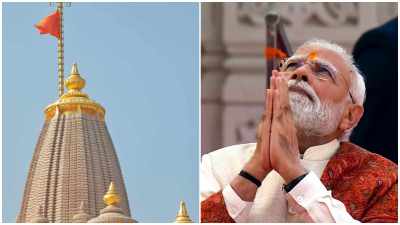IITs have failed to address a crisis: Students lack the freedom to choose their branch
'Fewer choices are driving IIT students away from engineering,' writes Kapadia.
 'While this is a complex problem, one way forward would be to give students the freedom to choose their branch of study after they are admitted to university,' writes IIT Bombay professor.
'While this is a complex problem, one way forward would be to give students the freedom to choose their branch of study after they are admitted to university,' writes IIT Bombay professor. — Anush Kapadia
There is a crisis in the undergraduate (UG) programs of IITs. There are two related symptoms arising out of it: UG students in the nation’s most prestigious engineering institutions are not becoming engineers; they are also not in the best mental health.
While this is a complex problem, one way forward would be to give students the freedom to choose their branch of study after they are admitted to university.
This would replace brutal external compulsion with internal motivation, ensuring that students really love what they learn because they chose it after exploring various options. This could be better than the suffering they are put through for four years in a branch they didn’t even know enough about to choose at age 18.
Freedom to choose would make for happier students who are actually invested in engineering. They could then be the agents of an industrial society that the IITs were set up to engineer.
Lulled into a false sense of success by the dazzling pay cheques of a handful of graduates who probably would have made it anyway, distracted by the daily grind of teaching and research, and perhaps immobilised by a sense that the task is beyond their institutional powers, the IITs have failed to address the crisis in their BTech programme. But there are several impediments to enhancing student freedom coming from students and parents as well.
The students and their parents are sanguine about the non-engineering outcomes of the IITs because “engineering” has long since been hollowed out at the UG level, becoming a code word for “general education” or “rigorous mental training” coupled with high academic prestige and a shot at upward mobility. IITs do not produce many engineers from their much-vaunted undergraduate program, but they do produce some winners in a society that has desperately few avenues for winning. Running this rat race is what focuses the minds of the undergraduate and their guardians.
In this way, “engineering” in India has become the equivalent of what Greek and Latin stood for up to the late 19th century in English and American higher education: a skill that was intrinsically useless but technically difficult, valued as a symbol of “being educated”, a credential providing access to the professions. Engineering in its essence is obviously not useless, but it has been made useless in India for a whole host of reasons such as our failed industrial policy, the ease of the brain drain to the service-sector dominated Anglosphere, and the caste-based hierarchy between mental and manual labour.
The sad proof of the hollowing out of the IITs’ undergraduate engineering education is that the top engineering students in the country do not go on to become engineers. Yet this is exactly the opposite in the United States. Data from the US Department of Education show us that a full 85 per cent of those with bachelor’s degrees in engineering go on to jobs related to their degrees.
Why is this? Because Americans have the freedom to choose their branch after they are admitted to the university, not before. They get a full two years of their four as UG students to explore different courses before they have to settle on a “major.” This obviously ensures that there is a much better fit between a student’s interest and aptitude and their branch or major. And this surely helps account for the innovative nature of the US economy.
This feature of American undergraduate education is not well appreciated in India, yet it is dominant in all universities, technical institutions, and indeed high schools. Thus you do not get admission into, say, MIT’s Computer Science department. You get admission into MIT as a university and then you have the freedom to choose the course in which you want to major. Lest we think that this means an automatic rush for Computer Science, MIT’s own data shows that only one in three MIT UGs choose computer science. Freedom to choose means students do not herd into fashionable majors; they in fact spread out across the university and find their individual calling, which is why their jobs are actually related to their education.
But we could reasonably argue that that Indian 18-year-olds lack the maturity and independence to go beyond the parental and societal writ and explore their own interests, perhaps especially when the future livelihood of the family is at stake.
Ironically, this is exactly the same argument that was made regarding American UGs during 19th century debates that brought freedom of choice into the American system. The detractors of the “elective system” argued that American UGs where nothing like those produced by the impressive German Gymnasium high schools. They, therefore, required a strict structure of Greek, Latin, and the classics to give them a broad, “liberal arts” education, broad enough to equip them for all future pathways. Out of these debates came that particularly American form of UG education: a broad set of “general education” requirements coupled with the freedom to choose your major.
Needless to say, we have to build our own system that suits our own conditions and aims. But our expectation that if all UG students were given a choice, they would choose Computer Science comes from our tacit assumption that our UGs can only behave as a herd, not as individuals. While this may well be true in the Indian context, this is arguably because UGs have not been given a safe space within which they can develop their individuality to begin with.
To continue to condemn undergraduates a choice-less education is in fact to hamper their ability to make independent choices at all. Yet the data show us that lack of choice is precisely what is driving IIT students away from engineering and into unhappy marriages with externally-enforced careers.
If the IITs are to be useful to the taxpayers that fund them and true to their mandate, they will encourage students to choose their branch after they are admitted, not before. IIT Bombay has made a start in this direction with a small undergraduate program that allows 30 students the freedom to choose. Being focused on the rat race has made students so risk-averse that most of them fail to see the value in the freedom to choose. But we are looking for a few outliers to get us started. Attitudes are naturally slow to change, so IIT Bombay is playing the long game on our students’ freedom to choose.
(The author is Associate Professor, Humanities and Social Sciences (HSS), IIT Bombay. Views are personal)
(A Lesson from IIT is a weekly column by an IIT faculty member on learning, science and technology on campus and beyond. The column appears every Friday)



- 01
- 02
- 03
- 04
- 05




























